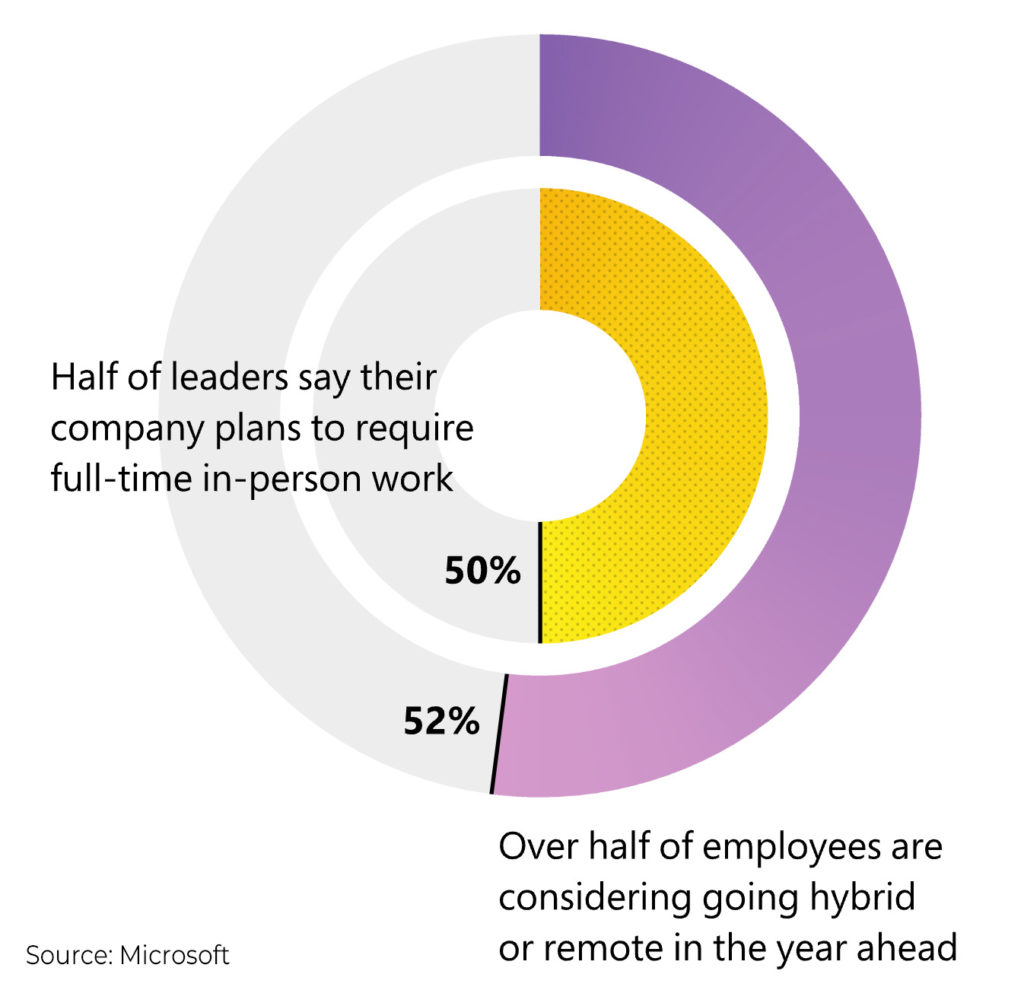To return to the office or not: that is the question on the minds of many leaders today.
However, as the number of people leaving their jobs (or planning to) continues to accelerate, finding the correct answer to the above question and developing one’s own return to office approach is becoming more urgent.
Returning in person is emerging as a real bone of contention between leaders and their employees. Fully 50% of leaders have indicated they want employees back in the office full time, according to the 2022 Microsoft Work Trend Index. However, in the same survey of tens of thousands of workers worldwide, more than half of employees are considering hybrid or fully remote roles.
It’s a difficult decision, and there’s no one size fits all answer. However, there are three crucial elements you can use as a lens to find the right return to office approach for your company, and those are culture, efficiency, and performance. Assessing in-person working versus remote work against these three factors will enable you to identify the most important things for both your business and your people, as well as any dependencies related to work location.
Understand your company culture
Maintaining and strengthening the organistaion’s culture is a constant priority. Understanding how culture operates within your organisation- how it is communicated, lived, and improved – as well as how it has evolved throughout the pandemic is an important lens through which you should view your company’s return to office plans.
As you consider your return to office approach, the question to ask yourself is what you want the culture to look like moving forward, including the aspects you want to change. Broadly, culture in a workplace is defined by what behaviours are rewarded, as well as those that are punished. However, culture relies upon the relationships between people and their connections to the business, as those are the invisible lines across which the culture is expressed.
Aspects of culture to consider:
- What are the defining characteristics of your company culture right now? (Consider both the positive and negative elements.)
- Of the defining cultural characteristics, you identified, which have the most impact on the business, and why?
- Which aspects of your culture are most valued by your employees?
- What changes in the culture would you like to see moving forward?
- What does senior leadership need to do to start modeling and developing these new cultural characteristics?
- Are these new characteristics dependent upon being in the office, and if so, why?
Going through this simple exercise will enable you to parse the most important elements of culture, as well as the aspirations for the business moving forward. Additionally, you’ll be able to identify which elements are dependent upon people being back in the office. This information should inform your return to office approach, as well as resulting communication to employees.
Evaluate efficiency
For this exercise, we are splitting the hairs between efficiency and performance, and are considering efficiency from an operational perspective.
Evaluating the differences in efficiency between the pre-pandemic norm and the radical shift to remote work that occurred in 2020 is made more difficult by the myriad exceptional variables we’ve encountered, including supply chain constraints, the difficulty many are experiencing in retaining adequate staffing levels, and the impact inflation and rising wages are having on profits.
Measures of efficiency to consider:
Focusing on core metrics the organisation has historically measured is the logical place to start. Recommended data that can help you assess the degree to which remote working affected efficiency include:
- Contact center data, such as calls per representative and cases resolved
- Task completion,
- Project delivery,
- Service levels.
Chances are good you will find variation between the elements you measure, and understanding these nuances is fantastic intelligence for leaders and will help you get to the right decision that is truly best for your business.
It’s also important to look at the big picture. The granular, metric-by-metric view can certainly uncover opportunities for further improvement. Looking at efficiency holistically, on the other hand, and observing trends in your selected metrics over time, can help you pick up interdependencies, and understand changes to the enterprise’s efficiency overall.
Assess performance data
Assessing performance is where you can concentrate on comparing the outcomes generated pre-pandemic and whilst your team was working remotely. While you may need to adjust for headcount and other variables, performance data should provide you with a clear picture of any differences in outcomes.
Performance factors to consider include:
- Customer satisfaction,
- Customer retention, especially if the organisation is rigorous about gathering loss data
- Conversion rates, including marketing metrics such as website visits to qualified leads, as well as sales conversion rates
- Quality metrics, such as software defects
- Revenue and profitability per client.
As with efficiency measures, it’s useful to look at performance metrics both in isolation and holistically. Customer satisfaction, for example, is often a function of the sales experience, customer support, and the quality of the product or service. Holistically, it’s a good indicator of how these areas of the business are functioning. However, inspecting underlying contributors can enable leaders to identify both areas of strength and opportunities to improve.
Pulling the data together & an example
Once you have developed your dataset and given careful consideration to the current and (desired) future state of the company culture, it’s time to draw your conclusions. Depending upon the organisation’s structure and industry, you may need to consider additional issues, such as what to do in the event one department clearly benefits from working remotely, while another just as clearly benefits from spending more time together. (In that circumstance, our recommendation is to allow department heads or managers to develop schedules for their teams, using guidelines established by leadership to ensure some consistency.)
By way of an example, your humble writer went through the culture exercise, answering the questions from the perspective of a past employer. I then highlighted the most important ideas and brought them together to form a return to office approach.
This was a really nice way of distilling the cultural attributes that were worth strengthening, as well as identifying objectives for cultural growth, as well as how those would be achieved. However, the conclusion was not what I’d recommend using as a statement to employees.
Keeping in mind that the most effective leadership communications are those that tell people what’s in it for them, I drafted a statement about returning to work and culture, using the key cultural attributes as the primary message points and imagining my former colleagues were the audience. The message makes it clear the organisation is prioritising a degree of in-office work. However, because the message provides the reasoning behind the decision, authentically acknowledges where the team stands, and doesn’t read like an edict, the likelihood of buy-in, and acceptance increases, and a palace revolt is avoided.
Sample message about culture and return to the office:
To: Everyone@companyname.com
From: CEO@companyname.com
Re: A new commitment to our employees
The hallmark of our culture is collaboration between the friendly and talented people who make up our team. We know collaboration is a key to both our business success and the employee experience. Ensuring our people have the opportunity to collaborate in person is, we believe, vital. However, we know times are changing, along with peoples’ preferences. We also know that historically, our work style has had too many meetings.
Today we are committing to improving our use of peoples’ time.
Finding the best ways to use time is important for both the business and its people, which includes finding the right balance between remote working and time together in the office. We don’t believe there’s value in being in the office for the office’s sake. However, we do believe there is value in being in the office for each other’s sake: for rebuilding friendships and welcoming our newest employees into the fold, and helping them build the kind of connections that make “friendly people,” and “great coworkers” consistent themes in our survey feedback and reviews of the company.
Here is how we propose to do this:
- Reduce the time spent in meetings by rolling out a new meeting format at all levels of the company to make meetings more focused and much shorter
- Reducing the number of meetings by using collaboration software to enable project leaders and teams to share documentation and status updates.
- Continue working from home part of the time, and asking department heads to work with their teams to build the schedules that make sense for them
- Using our time together in the office for the high-collaboration activities – such as brainstorming, strategy planning, training and development, and information sharing – that we all value
- Ensuring our newest hires don’t feel isolated, and can build the connections with others that will enable them to fully enjoy the friendliness and supportiveness that have come to be our cultural hallmarks.
Speaking of feeling supported and connected to others, that’s as important for the rest of us as well as for our newest players. There’s no question that the experiences of the last two years have changed us all as people. Recency bias being what it is (in short, our brains weigh our most recent experiences more highly than they do those from our past) one of our goals is also to help everyone feel more normal, more supported, and once again find joy in human company.
“Human company” is also a good description of what we aspire to be – a most human company whose employees know they are valued above all else.



